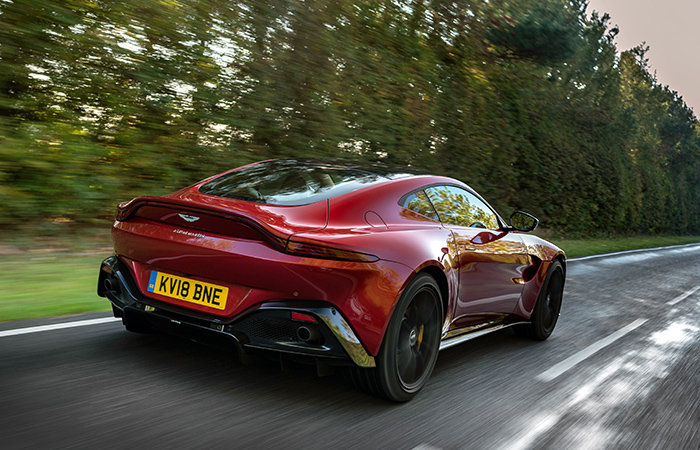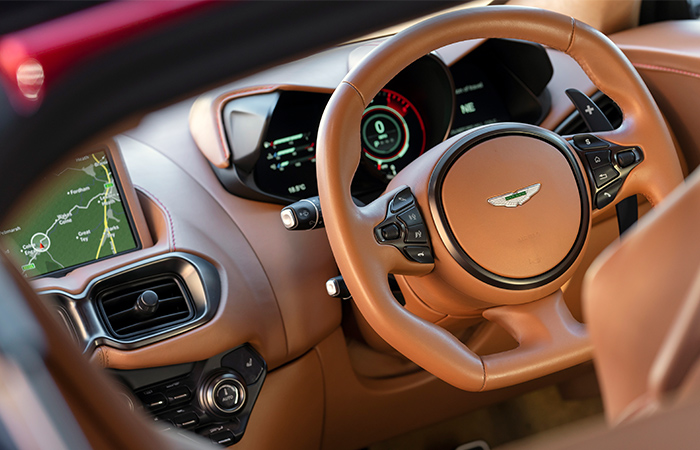An all-new design brings the baby Aston Martin bang up to date
There’s something unmistakably Aston Martin about the new Vantage. It has the British marque’s characteristic blend of aggression and sophistication – like a cage fighter squeezed into a Savile Row suit. But in other respects it’s quite different to the cars that have gone before it, and indeed the rest of the current range.

While the previous Aston Martin line-up sometimes felt a bit like a set of Russian dolls – each one an incrementally different take on the same theme – there is a concerted effort to give every model its own distinct character. For the Vantage, this remit is very clear: It is intended to be the most driver-focused car in the range; not necessarily the fastest or most powerful, but the one that delivers the purest sense of connection and involvement.
That’s not to say there isn’t a certain amount of commonality. Under the steel panels you’ll find a bonded extruded aluminium structure that’s loosely based on that of its bigger brother, the DB11. The front section of the chassis – roughly as far back as the windscreen – is structurally identical (although the tuneable components, such as suspension bushes and engine mounts, are unique to the Vantage). From that point rearwards, virtually everything is bespoke. In fact, Aston Martin says around 70 per cent of the structure is new.

It also marks a significant departure from the old Vantage. Whereas the previous chassis used lots of straight extrusions, the new platform relies heavily on castings that can be shaped to maximise the available space. That’s good news for passengers and their luggage – at 350 litres, the boot is now larger than that of a Ford Focus – but it also gives the engineers room to accommodate things like larger wheels and a bigger fuel tank.
If anything, the new Vantage should consume less super unleaded than its predecessor. Gone is the old 4.7-litre naturally aspirated V8, replaced by a 4-litre twin turbocharged unit sourced from Daimler. While the base engine is essentially the same as that found in the Mercedes-AMG GT (and indeed the go-faster versions of various Mercedes saloons), the rest is all Aston Martin.
Prod the starter button and the V8 crackles into life. It instantly sounds different to the Mercedes-AMG versions of the engine, largely thanks to the bespoke intake and exhaust systems, tuned to deliver more mid and high-frequency content. What this translates to is a sound that’s more sophisticated than the brawny muscle car burble of the AMG GT, yet every bit as potent.
The performance is in a different league to the old V8 Vantage, with 503bhp at 6,000rpm and (more significantly) 685Nm of torque from just 2,000rpm. True, it’s not McLaren 570S or Porsche 911 Turbo fast, but this is just the start for the new Vantage, with strong hints that there will be faster versions to come. More to the point, it’s delivered in one vast sweep, right up to the 7,000rpm red line, with pin sharp responses and a total absence of turbo lag.
Along with its AMG cousins, this is perhaps the one turbocharged engine out there that could genuinely pass for a naturally aspirated unit. The ‘hot vee’ layout – placing the turbochargers between the cylinder banks so they’re closer to the combustion chambers – certainly helps, but no other manufacturer has done it with quite the same degree of success.
Sharper dynamics
It only takes a matter of yards to appreciate the work that’s gone into pitching the Vantage towards the more driver-focused end of the spectrum.
In the softest of its three chassis modes, the body control feels similar to the DB11 at its firmest. There’s a heightened sense of connection too, with cat-like reflexes, which belie the Vantage’s comparatively hefty kerbweight (quoted as 1,530kg dry).
Fuel efficiency targets mean that Aston Martin has finally caved in and adopted electric power-assisted steering (EPAS) in place of the old hydraulic system. It’s pleasingly direct, with just the right rate of response to make the Vantage feel agile rather than nervous. As with most EPAS systems, however, the one area where it struggles is feel. In fairness, there is some genuine feedback to be had, but only once you’re leaning on the chassis quite hard. It certainly doesn’t chat away to you like the old Vantage.
When it comes to point-to-point pace, however, the new car deals a crushing blow to its predecessor. Even on cold, damp B-roads the bespoke Pirelli P Zero tyres do a remarkable job of handling the V8’s mammoth torque. It helps that the new structure is around 20 per cent stiffer than the old one, while the rear subframe is now mounted direct to chassis (without the deformable bushes used in the DB11). The downside to this is that there is a touch more road noise than you might expect, but that’s arguably in-line with the Vantage’s remit as a sports car rather than a luxury GT.
Occasionally you can sense the electronically controlled differential making minute adjustments under power, but it’s never intrusive. This works hand-in-hand with dynamic stability control (DSC) and a brake-based torque vectoring system to make the Vantage feel incredibly approachable for a 503bhp rear-wheel drive sports car. The more aggressive chassis modes slacken the safety net somewhat and for those feeling brave there is also the option of disabling the DSC completely.
Along with turbocharging and EPAS, another change that had the potential to upset the purists was the decision to use an automatic gearbox. Here, however, the news is good. Not just because there will soon be a proper manual version available, but also because the standard ZF 8-speed auto is light years ahead of the old robotised Sportshift unit. Being a torque converter design it provides smooth progress in fully automatic mode, but it also does a very passable impression of a dual clutch transmission (DCT) when you want to change gear yourself. The shifts are quick and crisp, the column-mounted paddles have a wonderfully tactile feel and the blipped downchanges certainly sound the part.
The cabin also adds to the experience. The driving position is spot-on, while the Daimler-sourced infotainment system and the virtual instrument cluster feel like they’ve skipped several generations on from the old Vantage. Build quality is now right up there with the Germans and the materials are generally very good too, although a couple of the plastic parts do seem a little stingy given the Aston’s £120,900 starting price.
Overall, then, it’s hard to find fault with the new Vantage. It’s a capable and entertaining sports car. And while it’s unashamedly driver-focused there is still enough comfort and refinement for longer trips. More importantly, cars like the Vantage and the DB11 show that Aston Martin is making good on its promise to strengthen the core GT and sports car models, as well as forging on with its ambitious plans to tackle new sectors. If this car is anything to go by, the future at Aston Martin looks very bright indeed.




Project to investigate hybrid approach to titanium manufacturing
What is this a hybrid of? Superplastic forming tends to be performed slowly as otherwise the behaviour is the hot creep that typifies hot...